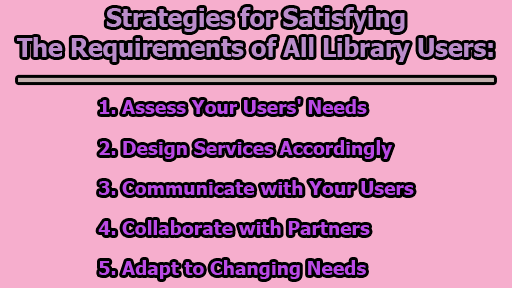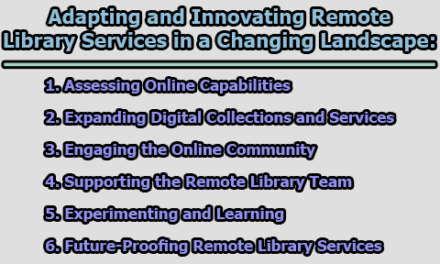Strategies for Satisfying the Requirements of All Library Users:
Libraries have long been cherished institutions that serve as dynamic and diverse spaces for individuals with a wide range of needs, preferences, and goals. Meeting the demands and expectations of an ever-evolving community is an ongoing challenge for libraries, and it requires a user-centered approach. In this article, we will explore the strategies for satisfying the requirements of all library users.
1. Assess Your Users’ Needs: Understanding your library users is the first step towards meeting their needs effectively. Various methods, such as surveys, interviews, focus groups, observations, feedback forms, usage statistics, and personas, can be employed to gather and analyze data about your users. These tools provide insights into user characteristics, preferences, behaviors, motivations, challenges, and satisfaction levels. Segmentation based on users’ needs and interests, whether they are students, researchers, seniors, children, or newcomers, enables libraries to tailor their services accordingly.
2. Design Services Accordingly: Once you have a comprehensive understanding of your users, it becomes essential to design services that cater to their unique requirements. This entails tailoring collections, programs, spaces, and technologies to align with users’ goals, preferences, and abilities. Libraries can offer a diverse range of formats and genres in their collections, from traditional books to e-books, audiobooks, magazines, DVDs, and streaming services. Similarly, diverse and relevant programs can cater to various age groups and skill levels. Inviting and functional spaces accommodating various activities, such as quiet study areas, collaborative zones, lounges, and maker spaces, are essential. Leveraging technologies like self-checkout machines, mobile apps, online catalogs, and digital resources enhance user access, convenience, and overall experience.
3. Communicate with Your Users: Effective and regular communication with library users is paramount. Libraries can utilize newsletters, social media, websites, blogs, podcasts, and signage to inform, educate, and promote their services. These communication channels also enable libraries to gather user feedback, suggestions, and opinions, which can be invaluable for service improvement. By engaging with users, libraries build trust, loyalty, and awareness in their communities. Insights and data gathered from user interactions can be used to evaluate and enhance services continually.
4. Collaborate with Partners: Meeting the needs of library users is not a solitary endeavor. Collaborating with stakeholders and partners who share the library’s vision and goals can be highly beneficial. Partners may include other libraries, community organizations, educational institutions, cultural groups, or businesses. Such partnerships expand the library’s reach, resources, and impact, fostering synergies, cross-promotion, and innovation. For example, partnerships with local museums can lead to joint programs and exhibits, while collaborations with local schools can offer valuable homework help or tutoring services.
5. Adapt to Changing Needs: Adaptation to evolving needs, expectations, and trends is a crucial aspect of meeting library users’ demands. Libraries should be flexible and responsive, monitoring and assessing their services regularly using both quantitative and qualitative measures. Staying informed about the latest developments and innovations in the field, such as emerging technologies, best practices, and research findings, is essential. As the world becomes increasingly digital, libraries must play a significant role in embracing these changes to remain relevant, useful, and attractive to their users.
In conclusion, libraries play an indispensable role in communities by providing access to knowledge, resources, and spaces for all users. To meet the diverse needs of their users, libraries must adopt a user-centered approach that emphasizes understanding, design, communication, collaboration, and adaptation. In an ever-changing, digital world, libraries will continue to be at the forefront of fostering engagement, learning, and satisfaction for their communities. By implementing these strategies and practices, libraries can remain vibrant and relevant institutions that truly meet the needs of all their users, both now and in the future.

Library Lecturer at Nurul Amin Degree College










